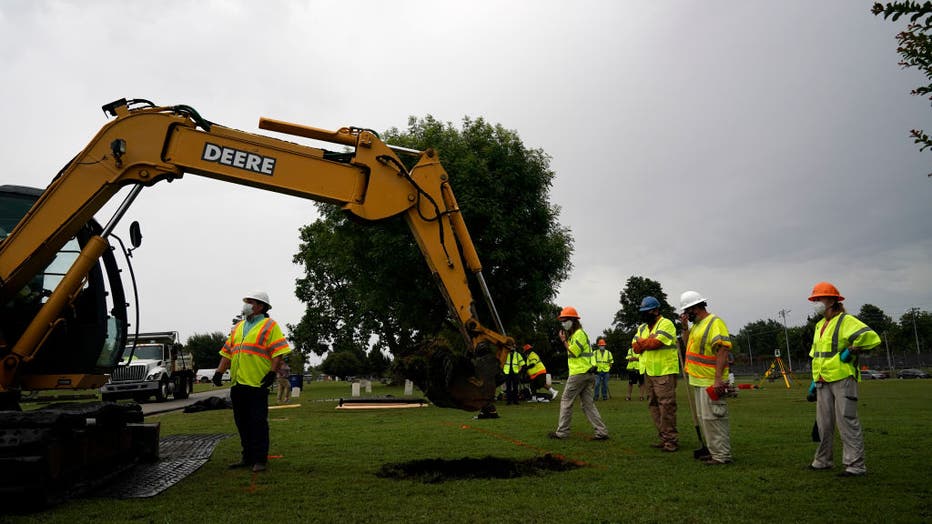More unmarked graves discovered in search for 1921 Tulsa Race Massacre victims
TULSA, Okla. - Officials in Oklahoma on Monday announced the discovery of 17 additional adult graves at an excavation site, part of the city’s effort to find unidentified victims of the 1921 Tulsa Race Massacre.
The recent discovery comes after the city of Tulsa in 2018 began an investigation into the events of the massacre, including the search for mass graves at various sites around the city. The 1921 massacre was inflicted by a violent White mob that targeted Black residents in Tulsa’s Greenwood District, often called "Black Wall Street," leaving more than 1,000 homes burned, hundreds looted, and a thriving business district destroyed.
Historians who have studied the event estimate the death toll to be between 75 and 300. But only 26 death certificates were issued in 1921 for victims of the massacre, 21 of whom were buried in Oaklawn Cemetery, according to the city.

FILE IMAGE - Archaeologists and observers watch during a test excavation of the 1921 Tulsa Race Massacre Graves at Oaklawn Cemetery in Tulsa, Oklahoma on July 13, 2020. (Photo by Nick Oxford for The Washington Post via Getty Images)
Last summer, an excavation in the Oaklawn Cemetery resulted in 19 exhumations of human remains. Of those, 14 remains fit the criteria for further DNA analysis, officials said.
The 14 sets of remains were sent to Intermountain Forensics in Salt Lake City, Utah, in an attempt to identify them. City spokesperson Michelle Brooks said two sets had enough DNA recovered to begin sequencing.
Last week, the city began a second excavation at the site. During this effort, experts found an additional 17 adult burials, with 16 of them exposed and 1 partially exposed, according to Oklahoma State Archaeologist Kary Stackelbeck.
Stackelbeck said on Monday that crew members would next come in with smaller tools, cleaning up the coffins by hand to get a better sense of each grave. She added that the team will observe the construction style, shape, and hardware to see if these coffins match the time period of the massacre.
If the team decides to exhume a body, they take extra care to stabilize everything before it is taken to a forensics lab.
"We are trying to do every step of this process as respectfully as possible," Stackelbeck said, adding that oversight committee members are present for transportation, as well as a "reverend, pastor, or some similar member of the clergy."
The latest search is expected to end by Nov. 18.
Intermountain Forensics is seeking people who believe they are descendants of massacre victims to provide genetic material to help scientists when they begin trying to identify remains of possible victims.
None of the remains recovered thus far are confirmed as victims of the massacre.
Victims were also never compensated, however, a pending lawsuit seeks reparations for the three remaining known survivors of the violence.
"I have lived through the massacre every day," Viola Ford Fletcher, one of the survivors, told a House Judiciary Subcommittee in 2021. "Our country may forget this history, but I cannot, I will not and other survivors do not. And our descendants do not."
Before being rushed out of her family home, Fletcher remembers feeling rich when she went to bed on the night of the massacre. Not just rich in terms of wealth, but in culture and heritage.
"We had great neighbors and I had friends to play with. I felt safe. I had everything a child could need. I had a bright future ahead of me. (The Greenwood District) had given me a chance to truly make it in this country," Fletcher recalled. "Within a few hours, all of that was gone."
This story was reported from Cincinnati. The Associated Press contributed.



